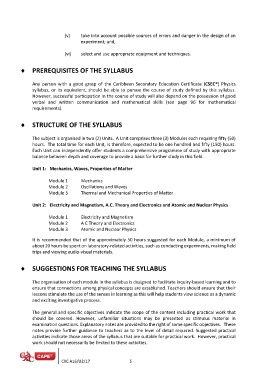Page 505 - SUBSEC October 2017_Neat
P. 505
(v) take into account possible sources of errors and danger in the design of an
experiment; and,
(vi) select and use appropriate equipment and techniques.
PREREQUISITES OF THE SYLLABUS
Any person with a good grasp of the Caribbean Secondary Education Certificate (CSEC®) Physics
syllabus, or its equivalent, should be able to pursue the course of study defined by this syllabus.
However, successful participation in the course of study will also depend on the possession of good
verbal and written communication and mathematical skills (see page 96 for mathematical
requirements).
STRUCTURE OF THE SYLLABUS
The subject is organised in two (2) Units. A Unit comprises three (3) Modules each requiring fifty (50)
hours. The total time for each Unit, is therefore, expected to be one hundred and fifty (150) hours.
Each Unit can independently offer students a comprehensive programme of study with appropriate
balance between depth and coverage to provide a basis for further study in this field.
Unit 1: Mechanics, Waves, Properties of Matter
Module 1 Mechanics
Module 2 Oscillations and Waves
Module 3 Thermal and Mechanical Properties of Matter
Unit 2: Electricity and Magnetism, A.C. Theory and Electronics and Atomic and Nuclear Physics
Module 1 Electricity and Magnetism
Module 2 A C Theory and Electronics
Module 3 Atomic and Nuclear Physics
It is recommended that of the approximately 50 hours suggested for each Module, a minimum of
about 20 hours be spent on laboratory-related activities, such as conducting experiments, making field
trips and viewing audio-visual materials.
SUGGESTIONS FOR TEACHING THE SYLLABUS
The organisation of each module in the syllabus is designed to facilitate inquiry-based learning and to
ensure that connections among physical concepts are established. Teachers should ensure that their
lessons stimulate the use of the senses in learning as this will help students view science as a dynamic
and exciting investigative process.
The general and specific objectives indicate the scope of the content including practical work that
should be covered. However, unfamiliar situations may be presented as stimulus material in
examination questions. Explanatory notes are provided to the right of some specific objectives. These
notes provide further guidance to teachers as to the level of detail required. Suggested practical
activities indicate those areas of the syllabus that are suitable for practical work. However, practical
work should not necessarily be limited to these activities.
CXC A16/U2/17 5

